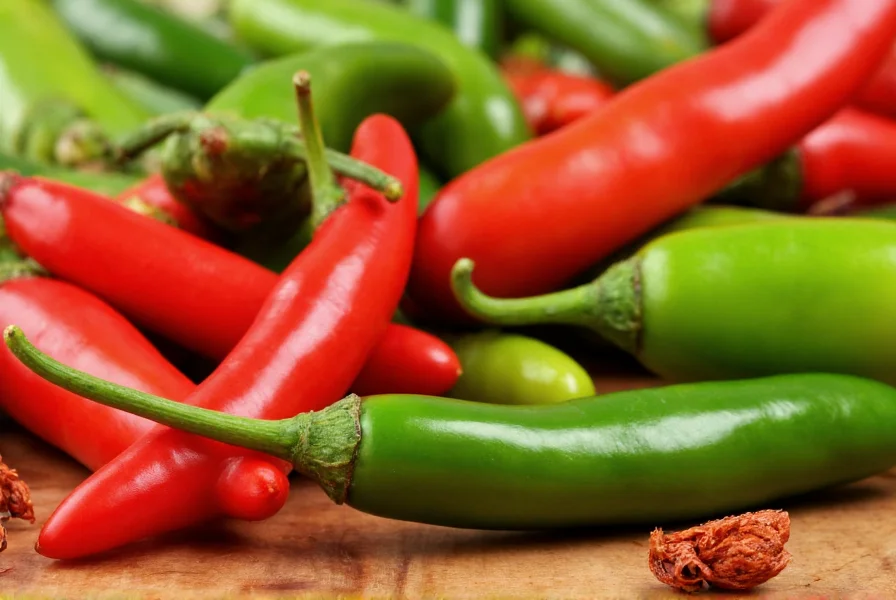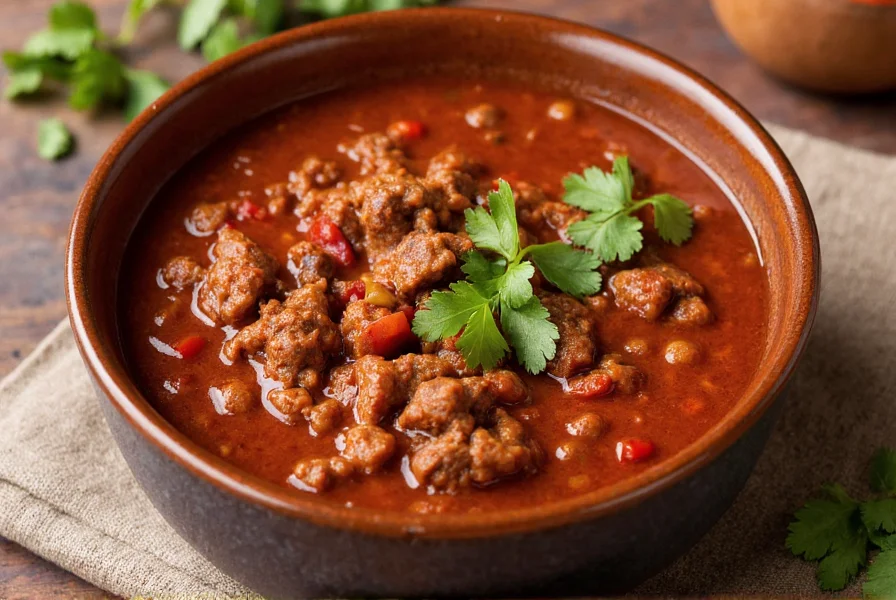The term chili (also spelled chilli or chile) has two primary meanings: (1) A hot pepper from the Capsicum genus, native to the Americas, known for its pungent heat; and (2) A spicy stew dish called chili con carne ("chili with meat"), typically made with ground or diced meat, beans, tomatoes, and chili peppers. The spelling "chili" is most common in American English, while "chilli" appears more frequently in British English.
When exploring the chili definition, it's essential to understand both botanical and culinary contexts. This dual-meaning term often causes confusion, but each usage has distinct origins and applications that have evolved over centuries.
Chili as a Pepper: Botanical Definition

The word chili primarily refers to any of the numerous cultivated varieties of the Capsicum genus, particularly Capsicum annuum. These flowering plants produce fruit that ranges from mild to extremely hot on the Scoville scale. The heat comes from capsaicin, a chemical compound concentrated in the pepper's placenta (the white ribs inside).
Chili peppers originated in Mesoamerica and South America, with archaeological evidence showing domestication as early as 6,000 years ago. Christopher Columbus encountered them during his voyages to the Americas, mistakenly identifying them as a type of pepper (related to black pepper), which explains the confusing nomenclature.
Chili as a Dish: Culinary Definition

Chili con carne (often shortened to "chili" in American English) is a spicy stew that emerged in the American Southwest, particularly Texas. Authentic versions typically contain:
| Traditional Ingredients | Modern Variations |
|---|---|
| Beef (usually chuck or brisket) | Turkey, chicken, or vegetarian alternatives |
| Dried chili peppers | Chili powder blend |
| Onions and garlic | Additional vegetables like bell peppers |
| Cumin | Various spices and seasonings |
| Tomatoes (in some regional versions) | Beans (controversial in traditional Texas chili) |
The dish evolved from Mexican carne con chile recipes, adapted by Texan settlers and cowboys who needed portable, non-perishable food. The 1893 World's Fair in Chicago helped popularize chili across America, leading to regional variations from Cincinnati chili to New Mexico green chili.
Spelling Variations and Regional Usage
Understanding the chili meaning requires acknowledging spelling differences:
- Chili - Predominant spelling in American English for both the pepper and the dish
- Chilli - More common in British English and Commonwealth countries
- Chile - Used in Spanish-speaking countries and sometimes in American English when referring specifically to the pepper
- Chile - Also the name of the South American country (pronounced "chee-lay")
These spelling variations don't indicate different meanings but reflect regional language preferences. The confusion between "chile" (the country) and "chili" (the pepper/dish) often causes misspellings in search queries like chile definition when users actually seek information about the spicy food.
Etymology and Historical Development
The word chili traces back to the Nahuatl (Aztec) word chīlli, referring to various hot peppers. Spanish colonizers adopted the term as chile, which entered English through Mexican-Spanish as "chili." The transition from "chile" to "chili" in American English occurred during the 19th century.
For those researching the chili etymology, it's fascinating to note how the term evolved differently across languages. In Spanish, it remains "chile" (pronounced "chee-leh"), while English speakers typically pronounce it "chill-ee" or "chill-eye." This linguistic journey explains why searches for what does chili mean often yield multiple interpretations.
Common Misconceptions About Chili
Several misconceptions surround the chili definition:
- Myth: All chili peppers are extremely hot
Fact: Heat levels vary dramatically, from mild bell peppers (technically in the same family) to extremely hot Carolina Reapers - Myth: Chili con carne must contain beans
Fact: Traditional Texas chili contains no beans; bean inclusion is a modern adaptation - Myth: Chili powder is a single spice
Fact: Most commercial chili powder is a blend of ground chili peppers, cumin, garlic powder, and other spices
Practical Applications of Chili Knowledge
Understanding the precise chili meaning serves several practical purposes:
- Cooking: Knowing whether a recipe refers to fresh peppers or the dish prevents culinary mistakes
- Gardening: Identifying proper pepper varieties for cultivation
- Travel: Understanding regional menus when visiting different countries
- Health: Recognizing capsaicin's potential health benefits and risks
For food enthusiasts exploring types of chili peppers, the Scoville scale provides a standardized measurement of heat intensity, ranging from 0 (bell peppers) to over 2 million units (pure capsaicin). Common varieties include jalapeños (2,500-8,000 SHU), habaneros (100,000-350,000 SHU), and ghost peppers (855,000-1,041,427 SHU).
Conclusion
The chili definition encompasses both a vibrant category of peppers and a beloved culinary tradition. Whether you're researching chili pepper definition for gardening purposes or seeking chili con carne meaning for cooking, understanding these dual meanings prevents confusion and enriches your knowledge of global food culture. The term's evolution from ancient Mesoamerican cultivation to modern culinary staple demonstrates how food terminology adapts across cultures and centuries.
Frequently Asked Questions
What's the difference between chili and chilli?
The terms are interchangeable with regional spelling preferences. "Chili" is predominant in American English, while "chilli" appears more frequently in British English. Neither spelling indicates a different meaning—the variation simply reflects linguistic conventions in different English-speaking regions.
Is chili con carne supposed to have beans?
Traditional Texas-style chili con carne does not contain beans. Beans were added later as a cost-saving measure during economic hardships. Purists argue authentic chili should only include meat, chili peppers, and spices, though many modern recipes and regional variations incorporate beans.
Why are chili peppers spicy?
Chili peppers produce capsaicin, a chemical compound that triggers heat receptors in mammals. This evolutionary adaptation likely developed to deter herbivores while still allowing birds (which don't feel the burn) to eat and disperse the seeds. The concentration of capsaicin varies by pepper variety, growing conditions, and even individual plants.
What does 'chile' mean in Spanish?
In Spanish, 'chile' (pronounced 'chee-leh') refers specifically to the pepper. The country name 'Chile' (pronounced 'chee-lay') is unrelated etymologically, deriving from a Mapudungun word meaning 'where the land ends.' This distinction explains why Spanish speakers don't confuse the pepper with the South American nation.
How do I measure chili pepper heat?
Chili pepper heat is measured using the Scoville scale, which quantifies capsaicin concentration in Scoville Heat Units (SHU). Originally determined through human taste testing, modern measurements use high-performance liquid chromatography. For reference: bell peppers (0 SHU), jalapeños (2,500-8,000 SHU), habaneros (100,000-350,000 SHU), and Carolina Reapers (1,400,000-2,200,000 SHU).










 浙公网安备
33010002000092号
浙公网安备
33010002000092号 浙B2-20120091-4
浙B2-20120091-4